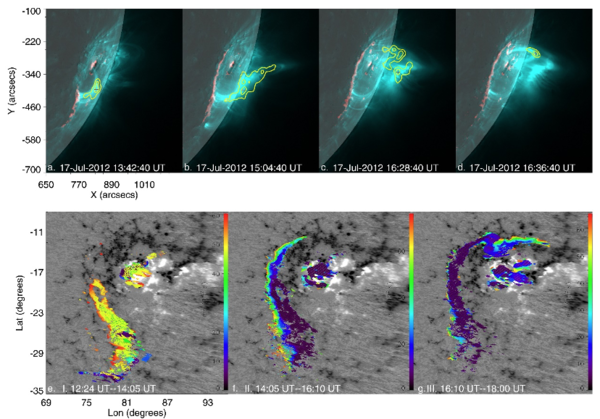Resolving two distinct thermal X-ray components in a compound solar flare
From RHESSI Wiki
| Nugget | |
|---|---|
| Number: | 423 |
| 1st Author: | Zhenjun ZHOU |
| 2nd Author: | Rui LIU |
| Published: | 27 December 2021 |
| Next Nugget: | TBD |
| Previous Nugget: | Bridging solar flares to coronal mass ejections |
| List all | |
Contents |
Introduction
Hot (10-20 MK) plasma is a prominent presence in nearly all solar flares. But occasionally "superhot" (30 MK) X-ray emission is seen above ordinarily hot flare loops (Ref. [1]). The superhot plasma is speculated to be directly heated by reconnection due to its proximity to a anticipated site of magnetic reconnection at a higher altitude in the corona. In this study (Ref. [2]), we investigate a compound solar flare that lasted for an extremely long duration and proceeded sequentially along a curved PIL. The flare was observed close to the west limb from the perspective of AIA and HMI onboard the SDO spacecraft, and close to the east limb from the perspective of the EUVI telescope onboard STEREO-A. These multi-wavelength and dual-perspective observations enable us to resolve the nature of two coexistent thermal X-ray components.
Identifying two coexistent thermal X-ray sources
The GOES M1.7 flare SOL2012-07-17 was termed "the slowest flare" in an earlier Nugget due to its long duration of over 12 hours. The time derivative of the GOES light curve exhibits three peaks, signifying three flaring episodes. The first and last episodes are associated with a fast and a slow coronal mass ejection, respectively. During the first episode, a superhot X-ray source is located at the top of the flare arcade (Figure 1a), which straddles the long "arm" of the Γ-shaped PIL (Figure 1(e-g)) and subsequently extends northward along the PIL during the seconnd episode (Figure 1b & 1c). During the third episode, a hot X-ray source is located at the top of a compact flare loop bundle (Figure 1c & 1d) that sits astride the short arm of the Γ-shaped PIL.

When both flare loop systems are present (Figure 1c), the HXR spectrum is found to be well fitted by combining a hot component (~12 MK) and a superhot component (~30 MK; Figure 2c). The superhot source is located at a higher projected position than the hot one, with their centroids being separated by 70 arcsec. That the two sources belong to two separated flare loop systems is further confirmed by STEREO-A/EUVI imaging from a different viewing angle.

Conclusion
The imaging and spectroscopic observations show that both thermal X-ray sources are located at the tops of the individual flare loop systems as expected; however, the superhot source is associated with an extended flare arcade and the hot source with a compact flare loop, which is reminiscent of the cases reported in Ref. [3]. It is not rare for homologous eruptions that originate from different segments of the same extended PIL to take place within a short time interval. Since different flare loop systems cool with different timescales and the flare maximal temperature is correlated with the flare class (e.g., Ref. [4]), we expect that the flare plasma in such compound events may consist of two or more coexisting thermal X-ray components of different temperatures, which are most likely distinct in space, but in certain circumstances may even appear co-spatial in projection.
References
[1] RHESSI Line and Continuum Observations of Super-hot Flare Plasma"
[2] "Resolving Two Distinct Thermal X-ray Components in A compound Solar Flare"
[3] "A Superhot Flare Observed by Yohkoh"
[4] "Statistical Properties of Super-hot Solar Flares"
| RHESSI Nugget Date | 27 December 2021 + |
| RHESSI Nugget First Author | Zhenjun ZHOU + |
| RHESSI Nugget Index | 423 + |
| RHESSI Nugget Second Author | Rui LIU + |